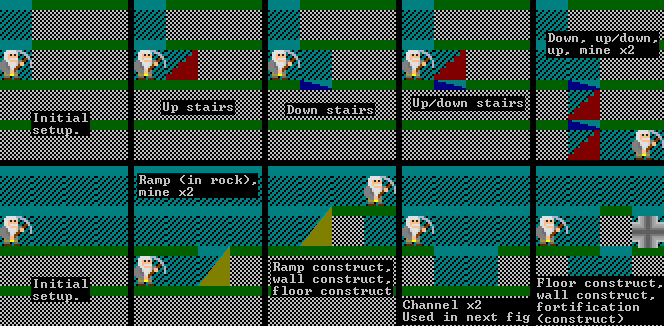- v50 information can now be added to pages in the main namespace. v0.47 information can still be found in the DF2014 namespace. See here for more details on the new versioning policy.
- Use this page to report any issues related to the migration.
Difference between revisions of "40d:Stairs"
(added how you get rid of those pesky down-stairs) |
|||
| Line 37: | Line 37: | ||
* If the stairs were constructed using the build menu, the following information applies: | * If the stairs were constructed using the build menu, the following information applies: | ||
| − | Stairs, as well as any type of construction built using {{k|b}}{{k|C}} can be removed using the "remove construction" designation {{k|d}}{{k|n}}. | + | Stairs, as well as any type of construction built using {{k|b}}{{k|C}} can be removed using the "remove construction" designation {{k|d}}{{k|n}}. If a downward stairway is getting in your way for some reason and you want to remove it, your dwarf will have to remove it from underneath. This is often pointless as your dwarf will need a downward stairway to get back up, and you may not want any downward stairways leading to the room at all. Since ramps don't have a floor component you can build a ramp for your dwarf to get back up, then seal it by constructing a floor over it. You can then happily build whatever you want on the tile, with the exception of walls, for some reason. Some other things might not be able to be built on the tile. |
[[Category:Designations]] | [[Category:Designations]] | ||
Revision as of 03:25, 25 October 2008
Stairs are a map feature that allows creatures to move vertically. Stairs provide access for dwarves and other single tile creatures, but are inaccessible to wagons. Stairs come in three forms: an upward stairway, a downward stairway, and an up/down stairway.
An up stair allows a creature to travel up to the next level if there is also a downward stair or an up/down stair on the level above. A downward stair can be stood upon and provides walking access to the adjacent tiles, like the other two stair types. An up/down stair counts as both.
They are distinct from ramps, which allow movement from one square to a horizontally adjacent square that is one level above, if moving off of the ramp, or below, if moving onto the ramp.
Creating stairs
Stairs can be created in two different ways:
- You can use the designations menu (d) to carve them out of a wall of unmined material (see digging).
- You can use the build menu (bC) to construct them in an open tile using material you have already gathered.
In order for stairs to be usable, you must construct stairs on both of the levels that you wish to connect (an up stair connecting to a down stair). However, a down or up stair will give you sufficient access to the adjacent level to build connecting stairs. This means you can dig directly downwards or even directly upwards using stairs without needing any other forms of access to the area.
Using an up/down stair (which goes both up and down on the same tile) you can dig a straight vertical shaft, which may be inadvisable.
It is currently impossible to construct down stairs over open space. To build a down stair over open space, a construction, usually an up stair, must be built on the Z-level beneath it.
You can't designate an up stair on a square that has already been dug out; you have to dig into an existing wall or build instead. You can then build the matching down stair on the level above. Furthermore, you can't designate a down or an up/down stair on the lowest level of the map. It is assumed that building an up or an up/down stair on the top level is equally difficult.
Danger of up/down stairs
At first, it may seem that there is no need to build downward stairs and upward stairs: if you really want, you can simply build up/down stairs everywhere, although this may be less aesthetically appealing. However, if a dwarf falls, they will not be stopped by an up/down stair but will be by an up stair. A surprising number of things make dwarves spontaneously fall, which normally does nothing, since they like to stay on flat ground. However, if they are, say, climbing a seven-tile-high tower with up/down stairs, you might want to replace your dwarf splatterer.
Destroying stairs
Depending on the method used to create the stairs, they can be removed using one of two different ways:
- If the stairs were created using the designations menu, the following information applies:
To destroy up stairs, use the "Remove Up Stairs/Ramps" command in the designations menu: dz.
To remove down stairs, dig a channel on them.
To eliminate up/down stairs, remove the up stair first.
- If the stairs were constructed using the build menu, the following information applies:
Stairs, as well as any type of construction built using bC can be removed using the "remove construction" designation dn. If a downward stairway is getting in your way for some reason and you want to remove it, your dwarf will have to remove it from underneath. This is often pointless as your dwarf will need a downward stairway to get back up, and you may not want any downward stairways leading to the room at all. Since ramps don't have a floor component you can build a ramp for your dwarf to get back up, then seal it by constructing a floor over it. You can then happily build whatever you want on the tile, with the exception of walls, for some reason. Some other things might not be able to be built on the tile.
